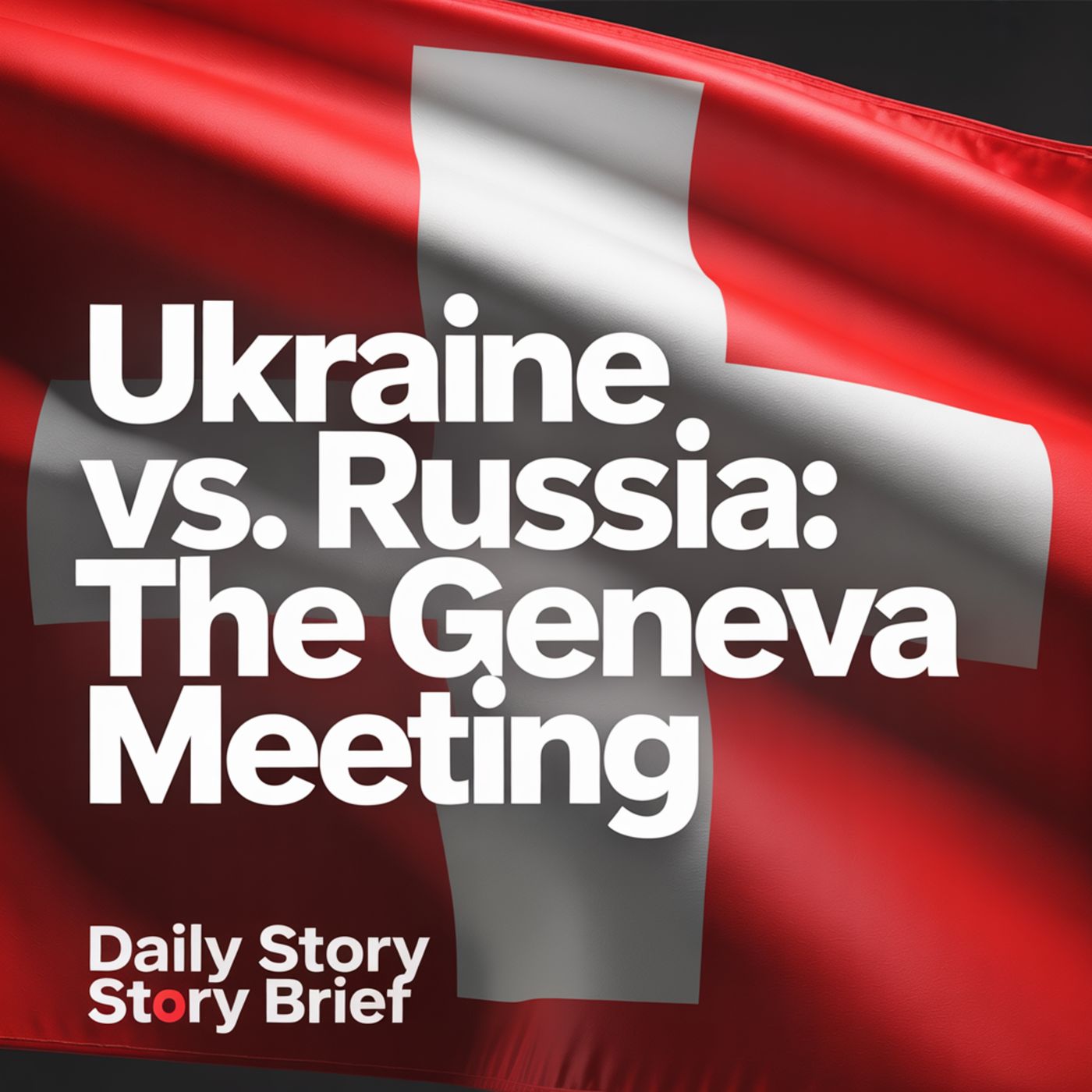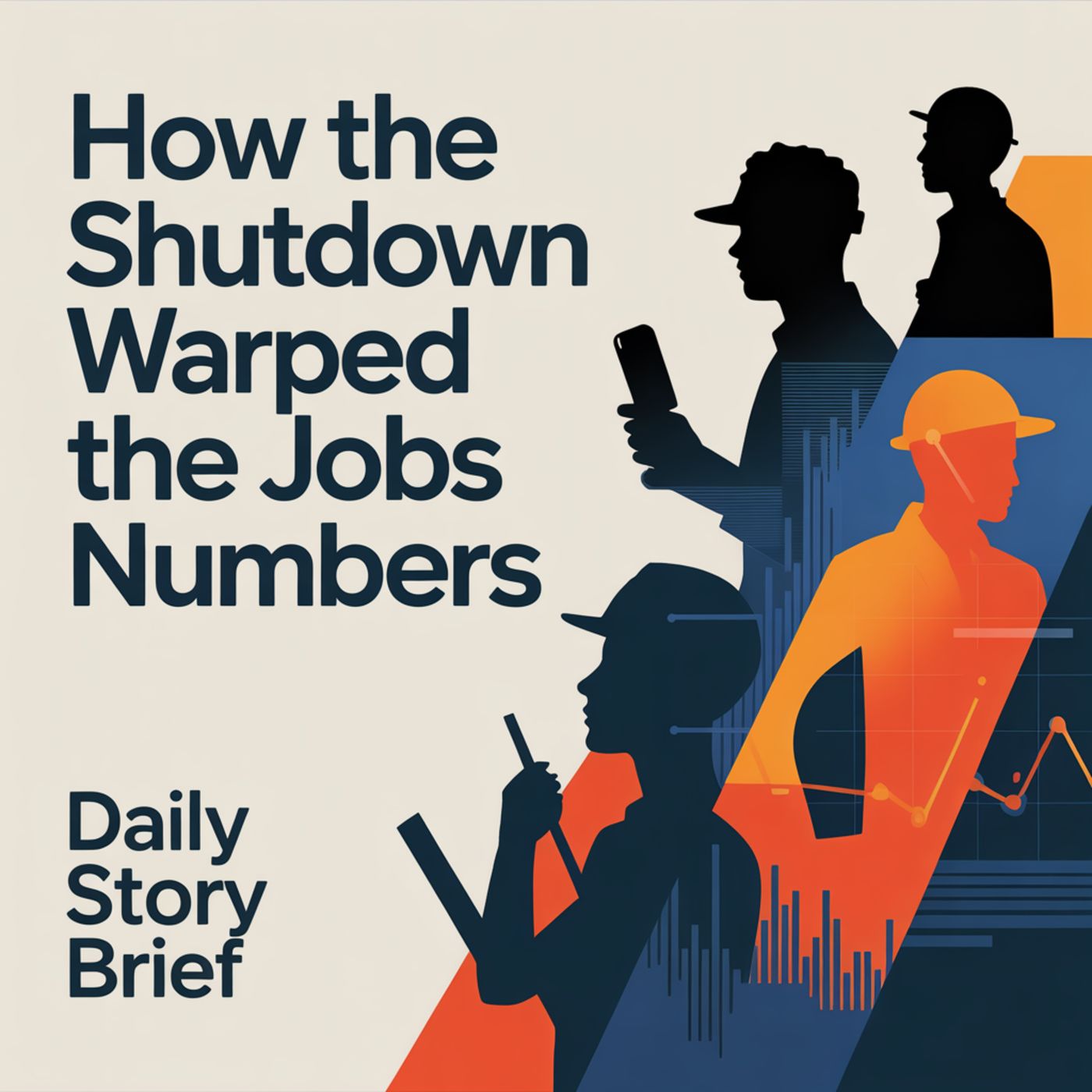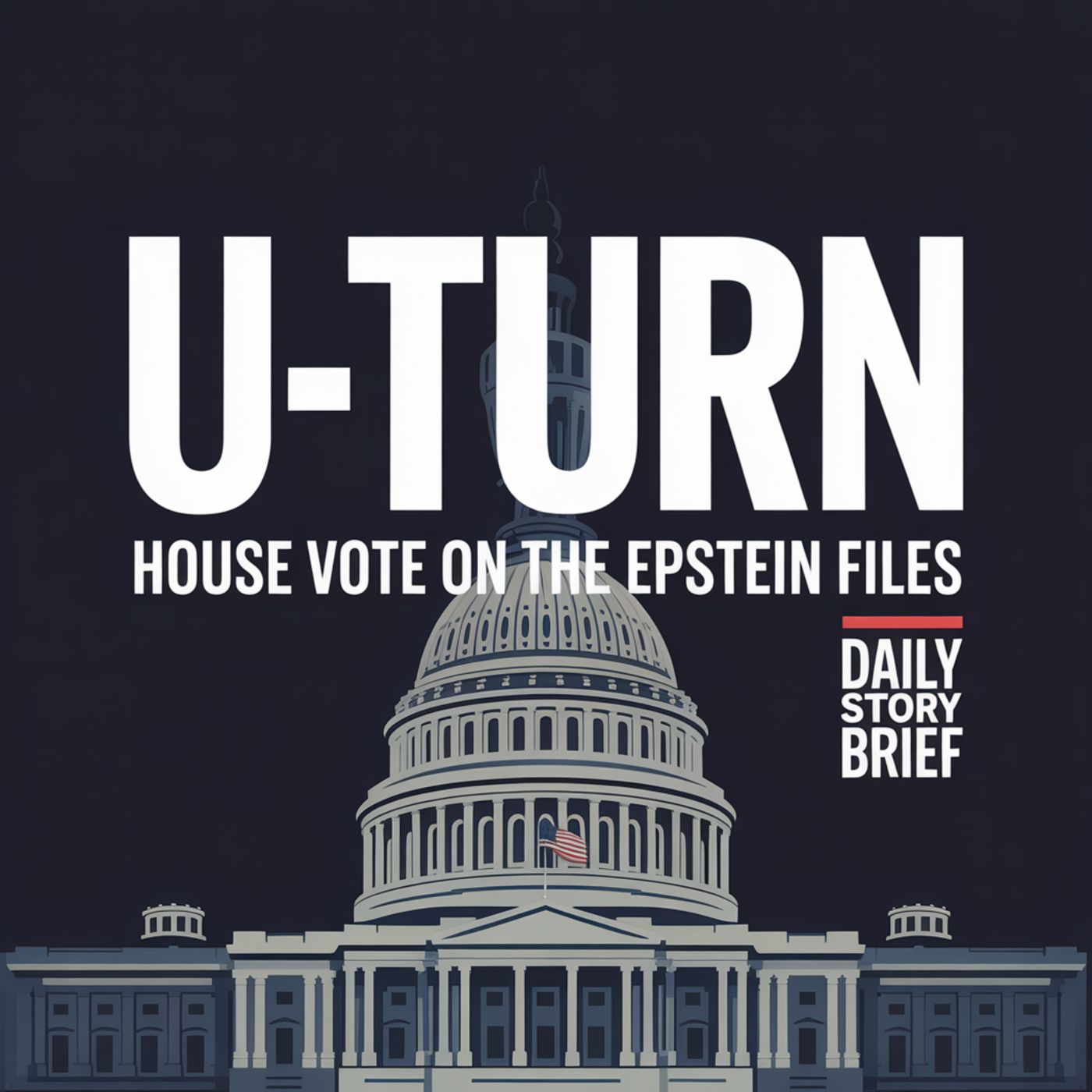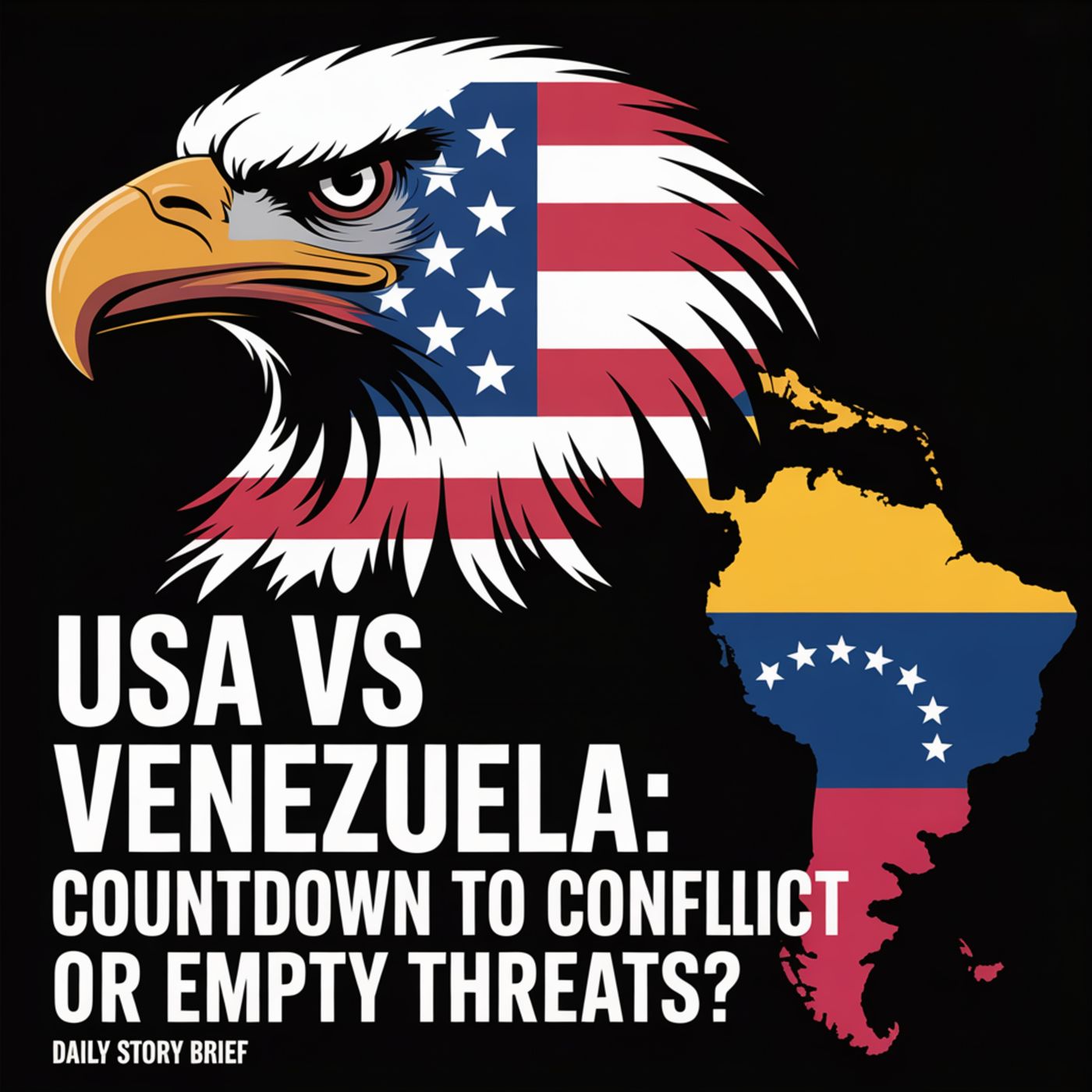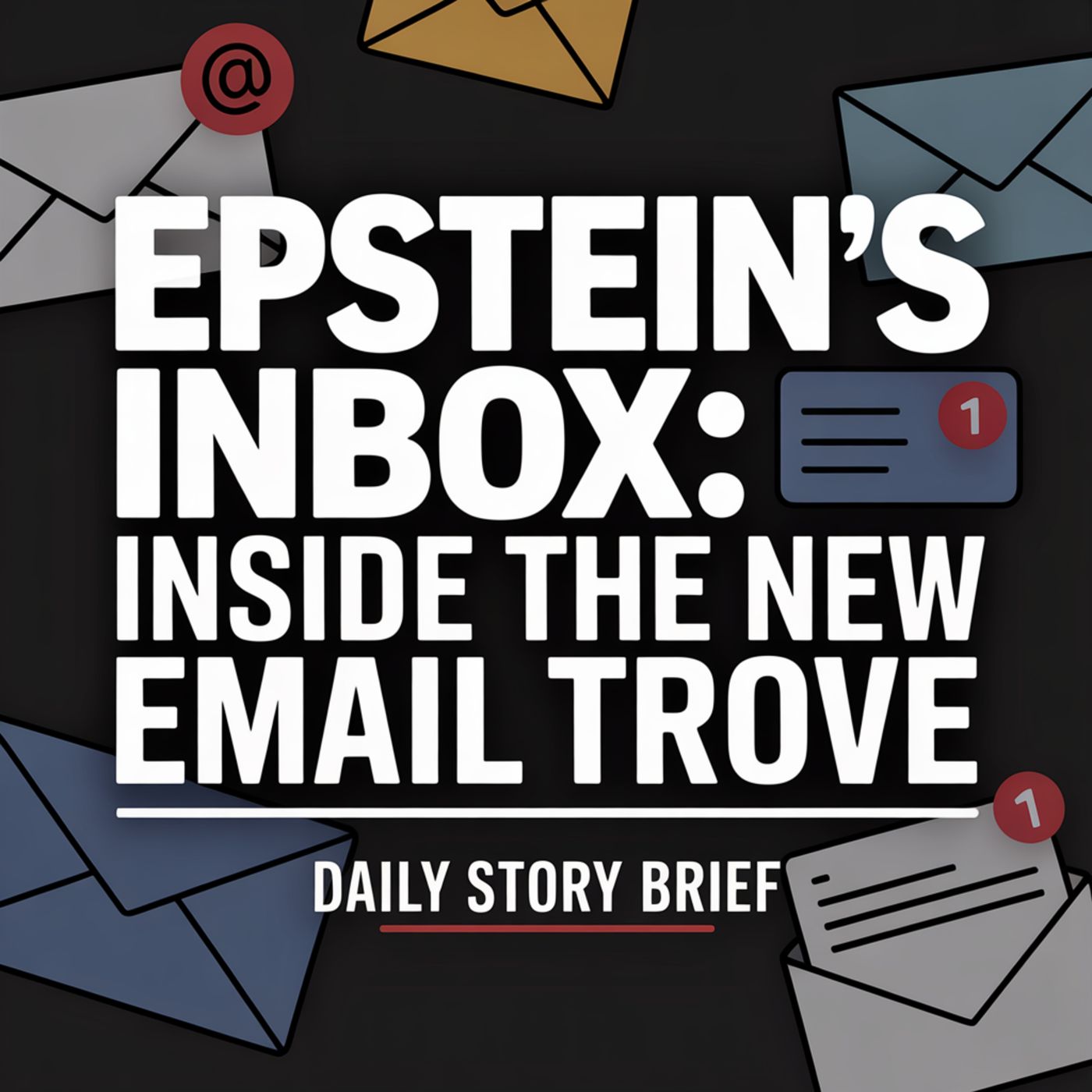Discover Daily Story Brief
Daily Story Brief

Daily Story Brief
Author: Instant Media Access
Subscribed: 0Played: 1Subscribe
Share
© Copyright Instant Media Access
Description
Daily Story Brief is a daily news explainer podcast that breaks down one important story a day so you actually understand what’s happening in the world. Each episode zooms in on a single headline and turns it into a clear, in-depth news breakdown: what happened, how we got here, and why it matters for you.Designed for busy people who want real current events context, Daily Story Brief cuts through the noise of endless updates and hot takes. You’ll get a focused daily briefing on politics, world news, global events, and social issues, explained in plain language with honest news analysis and commentary—no clickbait, no shouting.Whether you listen on your commute, during a walk, or while making coffee, this news podcast helps you stay informed, improve your media literacy, and understand the news behind the headlines. If you want fact-based, nonpartisan news that goes beyond surface-level coverage, subscribe to Daily Story Brief and get one story, clearly explained, every day.
13 Episodes
Reverse
In this episode of Daily Story Brief, the hosts unpack a tragedy in the heart of Washington, D.C. that spirals from a shocking ambush into a full-blown immigration and national security crisis. Two West Virginia National Guard soldiers are targeted near Farragut Square the day before Thanksgiving, leaving Specialist Sarah Beckstrom dead and Staff Sergeant Andrew Wolfe fighting for his life. The conversation begins with the grim details of the attack and the controversial National Guard deployment they were serving on—a mission a federal judge had just ruled likely illegal before putting the order on hold.From there, the episode digs into the background of the alleged shooter, Ramanullah Lakanwal, an Afghan national who drove across the country to carry out what the FBI is calling an act of domestic terrorism. The hosts trace his path into the United States through Operation Allies Welcome, his long service in CIA-backed Afghan “Zero Units,” and the serious human rights allegations that surrounded those forces. They examine reporting that suggests Lakanwal was a trusted counterterrorism asset but also someone marked by extreme trauma, loss and moral injury, raising hard questions about what happened after he was granted asylum.The story then shifts to the political explosion that followed. The episode walks through how the administration immediately framed the shooting as proof of a broken immigration system, even as facts emerged that his asylum had been approved only months earlier. Listeners hear how the attack was used to justify sweeping new measures: halting all Afghan immigration processing, promising to “pause” migration from so-called third world countries, launching a retroactive review of green cards from 19 nations, and dramatically ramping up interior enforcement using multi-agency street arrests meant to be impossible to ignore.Alongside these policies, the hosts track the rhetoric that accompanied them—from confrontations with journalists to hardline claims that mass migration and assimilation have “failed.” They bring in historians, policy experts and advocates to put those arguments in historical context, connecting them to earlier waves of anti-immigrant fear and to the legal concept of collective punishment. The Afghan American community’s response, UN warnings about international law, and the everyday reality of heightened raids, financial scrutiny and neighborhood alarm round out the picture.Ultimately, this episode is not just about one horrific shooting. It’s about what happens when a single act of violence involving a former U.S. ally becomes the catalyst for a fundamental shift in immigration policy. The hosts leave listeners with the uncomfortable, central question that now hangs over U.S. strategy: after relying on paramilitary partners like the Zero Units for years, how should America balance its moral obligation to protect those allies with its responsibility to safeguard domestic security—and what does that balance look like in practice when fear and politics collide?
In this episode, we walk through the abrupt and stunning end of the Georgia election interference case — the prosecution that many legal experts once saw as the strongest and most durable criminal threat to President Trump over 2020.The hosts start with Judge Scott McAfee’s brief but decisive order on November 26, 2025, dismissing the entire Georgia RICO case against Trump and his remaining co-defendants. From there, they rewind to the sweeping 2023 indictment, the use of Georgia’s racketeering law, the infamous Raffensperger “find 11,780 votes” call, the fake electors scheme, and the Coffey County voting machine breach. They unpack why prosecutors tried to frame all of this as a single “criminal enterprise” — and why that strategy was always controversial.Then the episode shifts into the procedural unraveling: the romantic relationship between DA Fani Willis and special prosecutor Nathan Wade, the bruising disqualification fight, and the Court of Appeals’ ruling that the “appearance of impropriety” alone was enough to remove Willis and her entire office. When no one else in Georgia wanted to inherit the case, Pete Skandalakis stepped in, only to conclude that the whole prosecution rested on the wrong legal theory — that what happened was fundamentally a federal matter, not a state RICO enterprise.From there, the hosts zoom out to the national picture. They connect Georgia’s collapse to the earlier demise of Jack Smith’s federal cases after Trump’s reelection and to the unusual outcome of the New York hush money conviction, where a 34-count felony verdict resulted in an unconditional discharge and no actual punishment. Taken together, they argue, these episodes expose just how difficult it is for the legal system to hold a sitting president or president-elect criminally accountable.Finally, the conversation turns to what comes next in Georgia. With the criminal cases over, Republican lawmakers are now pushing aggressive changes to the state’s election rules ahead of the 2026 midterms — from rolling back mail-in voting and ballot drop boxes to proposals for hand-marked paper ballots, handwritten voter lists, and even paid incentives for mass voter challenges. The hosts also examine reports of new federal activity around Fulton County ballots and how that could deepen distrust and fuel a fresh battle over who controls elections: local officials, state legislatures, or Washington.It’s a deep dive into how one case that began as a “firewall” against presidential immunity ended as a cautionary tale about legal strategy, prosecutorial conduct, and the fragile balance between state power, federal oversight, and the right to vote in Georgia.
In this episode of Daily Story Brief, the hosts take you inside an extraordinarily tense weekend of diplomacy in Geneva, where American and Ukrainian officials scramble to salvage a U.S.-backed 28-point peace framework for ending the nearly four-year Russia-Ukraine war. What was billed as a bold peace initiative has instead sparked alarm in Kyiv, outrage across Europe, and accusations that Washington is quietly pushing a “Russian wish list” on its own ally.The conversation starts with the battlefield reality driving this rush for a deal: Ukraine has lost hundreds of square kilometers in recent weeks, and the White House has set an aggressive Thanksgiving deadline for Kyiv to accept a draft that many in Ukraine see as nothing short of surrender. From there, the episode pulls apart the most explosive provisions of the original plan – sweeping territorial concessions beyond current front lines, a constitutional ban on NATO membership, strict caps on the size of Ukraine’s armed forces, and a prohibition on long-range missiles that would leave the country structurally weaker and vulnerable to future aggression.The hosts then zoom in on the clause that triggered a moral shockwave: a blanket post-war amnesty for all parties, effectively wiping away accountability for atrocities in places like Bucha. You hear the raw reactions from soldiers at the front and survivors visiting mass graves, torn between the desperate desire for the war to end and the horror of being asked to “forgive” without justice. The episode also traces how these provisions ignited a political firestorm in Washington and European capitals, with lawmakers and security experts warning that the plan risks repeating the mistakes of the Budapest Memorandum and undermining the very principle that borders cannot be changed by force.Beyond the military and moral questions, the episode exposes the financial engineering buried inside the blueprint. The hosts unpack the proposal to use frozen Russian central bank assets held in Europe for a U.S.-led reconstruction scheme that would deliver significant profits to American interests and channel remaining funds into a joint U.S.-Russian investment vehicle. They explore why this structure infuriated European leaders, who see it as rewarding the aggressor, shifting legal risk onto the EU, and intertwining private profit with peacemaking.As the narrative returns to Geneva, the episode explains how Secretary of State Marco Rubio, Ukrainian officials Andriy Yermak and Rustem Umerov, and their teams tried to rewrite the document under enormous time pressure and political scrutiny. The joint statement that followed promised a revised framework that reflects Ukrainian national interests and provides “credible and enforceable” security guarantees – but offered almost no detail on whether the most controversial points on territory, military limits, and amnesty were truly removed or merely repackaged.Finally, the hosts step back and ask the bigger strategic questions: What leverage does the U.S. really have over Moscow if Russia believes time and territory are on its side? What does an ironclad security guarantee for a non-NATO Ukraine actually look like in real-world terms? And at what point does a peace deal stop being peace and start looking like surrender disguised as diplomacy?If you want a clear, unsparing guide to one of the most consequential – and contested – peace efforts of the war, this episode lays out the stakes, the flaws, and the unresolved questions behind the Geneva talks, and asks what kind of agreement could deliver not just quiet for a season, but a genuinely durable peace.
In this episode of Daily Story Brief, we unpack the most controversial “peace plan” yet to emerge from the war in Ukraine—a secretive 28-point framework drafted not in official ministries, but in private jets and back-channel meetings between two unconventional power brokers.The hosts walk you through the origins of the proposal, tracing how U.S. special envoy Steve Witkoff, a New York real estate developer and personal ally of the White House, teamed up with Russian economic envoy Kirill Dmitriev, the Kremlin-linked head of Russia’s sovereign wealth fund, to build a plan that bypassed traditional diplomatic channels and largely excluded both Europe and Ukraine from the initial drafting process.From there, the episode dives into the core substance of the framework: massive territorial concessions by Ukraine, permanent loss of Crimea and the entire Donbas, a frozen front line in Kherson and Zaporizhia, and even a demilitarized buffer zone that becomes Russian territory on the map. Ukraine would accept strict caps on its armed forces, surrender long-range weapons, and enshrine permanent NATO non-membership in its own constitution, while NATO itself would formally close its doors to Ukraine.In exchange, Ukraine is offered “NATO-like” security guarantees that sound strong on paper but are carefully written to remain ambiguous in practice. The hosts break down what those guarantees actually mean, how far they really go, and the fine print that voids them if Ukraine ever tries to retake its lost territories by force. They explore the central paradox: a shield that protects a smaller Ukraine, but also chains it to a new map it can never legally challenge.The episode then turns to the money. You’ll hear how hundreds of billions in frozen Russian assets become the engine of a huge reconstruction package—structured in ways that would deliver significant profits to U.S.-led ventures—and how the plan offers Moscow a staged return from isolation: sanctions relief, a path back to the G8, and a sweeping U.S.–Russia economic partnership spanning energy, AI, data centers, and Arctic resources.Alongside the legal and financial architecture, the hosts dissect the most explosive clause of all: a universal amnesty for “all parties involved in the conflict.” They examine how this could shield alleged war criminals and corrupt officials on both sides, shut down ongoing investigations into atrocities like Bucha, and force Ukrainians to trade justice and accountability for a ceasefire.Throughout, you’ll hear reactions from Kyiv, European capitals, and Moscow—from Zelensky’s careful public tightrope walk to furious condemnation inside Ukraine, to European leaders warning of “capitulation,” to Kremlin-aligned commentators openly speculating about financial blackmail, coups, and even “heroic death” if Kyiv refuses to sign.Finally, the hosts zoom out to the biggest question of all: does this 28-point blueprint represent a realistic path to ending the killing, or is it an updated version of Munich 1938—rewarding aggression, locking in imperial gains, and all but guaranteeing that today’s “peace” becomes tomorrow’s even larger war?If you want to understand how one back-channel document could redraw the map of Europe, reshape Western unity, and test the limits of justice in the name of peace, this is an episode you don’t want to miss.
In this episode of Daily Story Brief, we walk straight into the heart of America’s economic “data fog” and unpack what might be the most important jobs report of the quarter—and the strangest. After a 43-day government shutdown that turned off the lights at the Bureau of Labor Statistics, the long-delayed September employment report finally lands on November 20th, just weeks before a make-or-break Federal Reserve meeting. The result is a tense, confusing snapshot of an economy that looks solid on the surface and deeply fragile underneath.The hosts start with the headline surprise: U.S. employers added 119,000 jobs in September, more than double what many Wall Street forecasters expected. Against consensus estimates around 50,000, the number looks like a clear sign of resilience. But when you stack it against the boom years of the post-pandemic recovery, or even the 12-month average of 147,000 monthly gains earlier this year, it feels more like a slower, late-cycle grind than a roaring labor market. We break down where those jobs really came from—an economy leaning heavily on healthcare, social assistance, restaurants and bars, with construction and retail holding on while more trade-exposed sectors falter.From there, the episode pulls apart the “good news” and shows the cracks. Wage growth is still running at 3.8% year over year, hotter than the 3.0–3.5% range many economists see as compatible with 2% inflation. At the same time, the labor force swelled by 470,000 people in September and participation climbed to its highest level since May, a sign that Americans are either feeling more optimistic about job prospects or more pressured to look for work. Yet that influx of job seekers pushed the unemployment rate up to 4.4%, its highest since 2021, and exposed worrying disparities—especially for Black women, whose jobless rate jumped sharply in a single month.Then comes the real gut punch: revisions. The hosts walk you through how the BLS quietly rewrote the summer, taking what had looked like a weak but positive stretch and revealing something closer to stall speed. July is revised down, and August, once reported as a modest gain, is flipped into a net loss of 4,000 jobs—joining June as the second negative month of the year. Add in clear job losses in transportation, warehousing, manufacturing, federal government, and temporary help services, and the picture shifts from “soft landing” to “low hire, low fire limbo” where people who already have jobs feel stable, but those hunting for work face months of rejection.The episode doesn’t leave this at the level of charts and acronyms. It connects the macro story to real lives: the avalanche of layoff announcements from corporate giants like Verizon, Amazon, Target, UPS, automakers and media companies, and the experience of job seekers sending hundreds of applications for a single interview. The hosts highlight how the average spell of unemployment has stretched to nearly six months, explaining why the labor market can look “fine” in the aggregate while feeling brutal on the ground.All of this funnels into a high-stakes dilemma for the Federal Reserve’s December meeting. With no October jobs report at all and the combined October–November data delayed until after the decision, the Fed is effectively flying blind. Hawks point to the 119,000 payroll gain and elevated wages as reasons to hold rates steady and keep pressure on inflation. Doves point to the negative summer revisions, higher unemployment, layoffs and sectoral weakness as clear evidence the labor market is deteriorating and needs relief. Layered on top are four big structural forces—tariffs and trade uncertainty, AI-driven productivity, the lagged impact of high interest rates, and shrinking labor supply from immigration crackdowns and retirements.
It looked like a state dinner ripped straight from a movie: fighter jets roaring overhead, a horse-drawn procession on the South Lawn, billionaires and celebrities in black tie on the White House grounds. But behind the spectacle of Saudi Crown Prince Mohammed bin Salman’s first visit to Washington in seven years was something far more consequential—a sweeping renegotiation of power, money, technology and morality between the United States and Saudi Arabia.In this episode of Daily Story Brief, we break down how one carefully choreographed visit turned into a wholesale reset of the U.S.–Saudi relationship. The hosts start with the symbolism of the reception itself: the flyovers, the guest list stacked with tech titans like Elon Musk and Tim Cook, global icons like Cristiano Ronaldo, and the unmistakable signal that Washington now sees MBS as the kingdom’s real decision-maker, head of state or not.From there, the episode dives into the heart of the new defense architecture. You’ll hear how the surprise designation of Saudi Arabia as a major non-NATO ally (MNNA) vaults Riyadh into an elite club alongside countries like Israel, Japan and Australia—without creating a NATO-style legal obligation for the U.S. to defend the kingdom. The hosts explain what this status actually unlocks: access to joint Pentagon research and development, faster procurement of sensitive weapons systems, priority access to surplus U.S. hardware, and even the ability for Saudi defense firms to bid on U.S. military maintenance contracts abroad.Then the focus shifts to the most controversial hardware on the table: the F-35. The episode unpacks why selling the U.S.’s most advanced stealth fighter to Saudi Arabia reshapes the regional balance of power and collides head-on with America’s legal obligation to preserve Israel’s qualitative military edge. You’ll learn how Washington tries to square that circle with “capability differentials,” custom upgrades for Israel, and even the ultimate failsafe—a software-based “kill switch” that could theoretically shut the jets down if they were ever turned against U.S. interests.But this visit wasn’t just about weapons. It was powered by an almost unimaginable number: a pledge to boost Saudi investment in the United States to nearly one trillion dollars. The hosts walk through how MBS is using that money as strategic leverage, tying his country’s Vision 2030 transformation to U.S. technology in artificial intelligence, semiconductors and data centers. They explain why Saudi Arabia’s cheap energy gives it a unique advantage in the AI race, how massive purchases of NVIDIA’s most advanced chips fit into that plan, and why U.S. officials are nervous about the risk of those technologies bleeding to China.The episode also explores the emerging civilian nuclear partnership between Washington and Riyadh: the promise of U.S.-built reactors, the clash over Saudi demands to enrich uranium on its own soil, and the talk of a potential U.S. nuclear umbrella as the only thing that might convince the kingdom to back down. That debate feeds directly into the larger strategic picture—deterring Iran, avoiding a devastating Gulf war, and perhaps even reviving some form of nuclear diplomacy.At the same time, the hosts dissect the diplomatic brick wall around the Abraham Accords. Despite securing almost his entire strategic wish list, MBS refused to give up his public demand for a guaranteed path to an independent Palestinian state as the price of normalizing ties with Israel. The episode lays out why that condition is politically impossible for Israel’s current government, why the post-Gaza climate makes normalization even more toxic in the Arab world, and what that stalemate reveals about the limits of even trillion-dollar leverage.
The political dam around the Epstein scandal has finally cracked—and this episode takes you right into the flood. As Congress races toward a House vote on the Epstein Files Transparency Act, the hosts unpack how a bill that was once dismissed as a fringe demand has turned into a full-blown political avalanche that neither party can control.You’ll start on Capitol Hill, where an unlikely duo—libertarian Republican Thomas Massie and progressive Democrat Ro Khanna—have spearheaded a bipartisan push to force the Department of Justice to release its full, unclassified files on Jeffrey Epstein and Ghislaine Maxwell. The episode walks through what the bill actually does: from demanding flight logs, detention records, and internal DOJ communications to requiring that everything be released in a searchable, downloadable format within 30 days. No more “thousand boxes of paper” document dump, no more excuses. Just data the public, journalists, and researchers can actually use.From there, the focus shifts to the political shockwaves. You’ll hear how intense public pressure and survivor activism flipped powerful opponents into reluctant supporters. Speaker Mike Johnson’s journey from blocking votes and slamming the bill as “recklessly flawed” to ultimately telling members to “vote your conscience” becomes a case study in what happens when party leadership collides with a furious electorate. The episode dissects his carefully hedged statement, his attempt to punt responsibility to the Senate, and Massie’s blunt response that the only real fear here is embarrassment for the powerful.At the center of the storm is President Donald Trump’s spectacular U-turn. For months he called the push for transparency a hoax and urged Republicans to oppose it. Then, almost overnight, he publicly endorsed the bill, vowed to sign it, and insisted “we have nothing to hide.” The hosts break down this reversal in detail: the political calculus behind accepting an inevitable vote, the spin from the White House claiming long-standing support for transparency, and the way right-wing commentators raced to reframe the change of course as a masterstroke rather than a retreat.But the episode doesn’t stop at the headlines. It digs into the fine print and the legal machinery that could still keep key information out of public view. You’ll learn about concerns that a wave of new investigations into prominent Democrats ordered just before Trump’s reversal could be used as a shield—reclassifying big portions of the Epstein file as “active evidence” and invoking standard exemptions that allow DOJ to withhold material tied to ongoing cases. Former prosecutors’ warnings about redactions, grand jury secrecy, privacy rules, and the enormous discretion of the attorney general all come into focus, revealing how a law meant to force openness can be blunted by technical legal maneuvers.The human center of this story comes from the survivors themselves. The episode revisits the powerful press conference on the steps of the Capitol, where women who were abused as teenagers confronted the most powerful man in the country directly. You’ll hear how Jenna Lisa Jones told Trump that she had voted for him and now considered his behavior on this issue a national embarrassment, and how Haley Robson’s line—“I am traumatized. I am not stupid.”—cut through the fog of talking points and spin. Their emotional testimony, and the launch of a nonpartisan, survivor-led movement to close systemic loopholes, are presented as the moral engine driving this entire moment.
Imagine waking up to find out that the system keeping thousands of planes safely separated in the sky is held together by unpaid workers running on overtime, second jobs, and sheer anxiety. That’s the reality this episode dives into.In this edition of Daily Story Brief, we unpack how the longest government shutdown in U.S. history pushed America’s air travel system right to the edge of failure—and how it was pulled back from the brink in a matter of days. For 43 days, the national airspace system ran on fumes as about 13,000 air traffic controllers and 50,000 TSA agents were ordered to keep working without pay, missing two full paychecks while still being legally required to show up.The hosts begin with the human cost: highly trained controllers taking second jobs driving for Uber, worrying about rent and groceries, and calling out sick as exhaustion and financial panic mounted. That strain quickly turned into a safety issue. We hear how the FAA started to see an alarming rise in loss-of-separation incidents, runway incursions, and pilot reports of controllers who sounded stressed, slow, or overwhelmed on the radio.From there, the episode traces the moment that strain turned into a full-blown safety crisis. The FAA introduced unprecedented emergency orders, forcing airlines at 40 major airports to cut flights—first by 4%, then 6%, with internal plans ready to go as high as 10% right before Thanksgiving. The hosts walk through the data: tens of thousands of delays, thousands of cancellations, and a single day where about 10% of all U.S. departures were wiped from the schedule. They explain how “staffing trigger events” at control facilities exploded to a record 81 in a single day, an internal alarm that the system was operating below its own safe limits nationwide.Then comes the whiplash: the near-instant recovery once the shutdown ends and funding is restored. The hosts show how, as soon as controllers knew back pay and bonuses were coming, call-outs plunged and staffing trigger events collapsed—from 81 down to just 1 in under a week. The FAA rapidly cut its flight reduction mandate from 6% to 3%, and by November 17th, it fully rescinded the emergency order, restoring normal operations just in time for the Thanksgiving travel crush.But the episode doesn’t stop at the surface. It pulls back the curtain on the structural weaknesses the crisis exposed. Listeners learn that the shutdown didn’t create the controller shortage—it weaponized an existing gap of 3,000–3,800 missing controllers in a system that had already been running on mandatory overtime for years. The hosts explore why hiring and training new controllers is a multi-year process, why the system remains fragile even after the emergency ended, and how close another major storm or disruption could push it back toward chaos.Finally, the conversation shifts to the policy battle now underway. Industry groups and airlines are pushing Congress to let the FAA use its own Airport and Airway Trust Fund—fed by ticket and fuel taxes—to pay controllers during any future funding lapse, insulating critical safety workers from political brinkmanship. The hosts connect this aviation story to a larger question: if the safety of U.S. air travel can hinge on the paychecks of a few thousand people, what other essential systems—cybersecurity, bridge inspections, public health—are quietly running with the same kind of hidden vulnerability?
At just 27 years old, Karoline Leavitt became the youngest White House press secretary in American history—and in this episode, the hosts ask a provocative question: is she really the new “first lady of power,” not through policy, but through pure narrative control?This Deep Dive episode traces Leavitt’s meteoric rise from small-town New Hampshire to the center of the West Wing. The hosts walk you through her roots in family small business, her years as the “token conservative” on a liberal campus, and the 2016 college op-ed that reads almost like a manifesto for her later war on “fake news.” You’ll hear how her early distrust of the media wasn’t a convenient talking point adopted later, but a core belief that shaped her entire political trajectory.From there, the conversation follows her fast climb through Trump-world: starting in presidential correspondence, moving into the press shop under Kayleigh McEnany during the COVID-19 outbreak, and then stepping fully into the spotlight with her own 2022 congressional run. The hosts unpack that campaign’s financial controversy—17 amended FEC filings and hundreds of thousands in unpaid debts—and explain why, in this political universe, loyalty and combativeness mattered more than a clean compliance record.But this episode isn’t just about résumé lines. It dives headfirst into Leavitt’s intensely scrutinized personal life and how it intersects with her public image. The hosts explore her unconventional marriage to New Hampshire developer Nicholas Riccio, the 32-year age gap that fuels endless online speculation, and the Halloween photo “photoshop” flap that turned a family snapshot into a mini media storm. They also examine her astonishingly brief maternity leave—returning to TV just four days after giving birth in the aftermath of an assassination attempt on the president—and ask what kind of precedent that sets for working mothers in high-pressure political roles.The heart of the episode, though, is Leavitt behind the podium. The hosts dissect her transformation of the press secretary from an information conduit into a political enforcer. They go line by line through her most explosive clashes: calling President Biden cognitively impaired, telling a reporter “your mom did” in a private text, branding the BBC a taxpayer-funded propaganda machine, and attacking federal judges as partisan operatives. You’ll hear how her strategy works: don’t just challenge questions—challenge the legitimacy of the people asking them.Using the government shutdown food-aid crisis and the Jeffrey Epstein files as case studies, the episode shows how Leavitt deflects damaging facts by reframing them as proof of a biased system at war with her boss. The hosts explain how she turns legal constraints, court orders, and document controversies into ammunition against “activist judges” and “liberal media,” all while insisting her side is the one embracing transparency.Finally, the conversation zooms out. What does it mean for democracy when the White House’s chief spokesperson openly defines her job as fighting a political war rather than informing the public? Has the traditional, semi-neutral press secretary—someone who at least pretends to referee between the president and the press—been permanently replaced by a Gen Z combatant whose mission is to delegitimize journalism itself?“Karoline Leavitt: The New First Lady of Power?” is part biography, part media-literacy lesson, and part warning flare. Whether you see her as a heroic loyalist or a dangerous accelerant in the war on the press, this episode gives you the context, the receipts, and the big-picture stakes behind one of the most controversial communicators in modern American politics.
The week’s headlines felt like a political earthquake, and this episode pulls you right into the epicenter. In “The Chaotic Week of Donald Trump,” the hosts of Daily Story Brief untangle a staggering series of overlapping crises—legal, economic, and geopolitical—to answer one question: what happens when an entire administration is forced into nonstop political firefighting?The episode opens with the explosive new releases from the Jeffrey Epstein files and the way they’ve detonated a civil war inside the Republican Party. You’ll hear how a massive 20,000-page document dump from Epstein’s estate reignites scrutiny of Donald Trump, why some emails and alleged messages raise profound questions about awareness and association, and how one investigative theory suggests Epstein may have been deliberately stockpiling “insurance” on powerful people. From there, the hosts walk you through the stunning public rupture between Trump and Marjorie Taylor Greene, her push for full unredacted DOJ files, his volcanic response and withdrawn endorsement, and the rare “procedural coup” in the House via a discharge petition that forces every member to go on record about releasing the full files.From internal party warfare, the conversation pivots to Trump’s legal and media battles. The hosts unpack the latest twists in the Georgia election interference case, including dropped charges on jurisdictional grounds and the dramatic reshuffling of the prosecution after DA Fani Willis is disqualified. They explain what it means for Peter Skandalakis to step in personally and what’s at stake as the case tries to avoid collapse. Then they zoom out to an international confrontation: Trump’s multibillion-dollar defamation threat against the BBC over a heavily edited January 6th clip. You’ll learn why media lawyers view the proposed $1–5 billion lawsuit as largely political theater, how it triggered high-level resignations at the BBC, and why UK leaders are keeping their distance.On the economic front, the episode dives into the administration’s collapsing approval on inflation and the sudden tariff reversal that followed. The hosts break down the numbers behind voters’ economic anxiety, the decision to roll back tariffs on everyday staples like beef, coffee, and fruit, and the parallel move to blame meatpacking giants for soaring prices. They dig into the paradox at the heart of Trump’s trade agenda: tariffs that are bad enough to quietly unwind while still being sold as the engine for future $2,000 “dividend” checks to most Americans. That contradiction becomes one of the central threads tying the week together.The deep dive then turns to domestic policy shockwaves from the end of the 43-day government shutdown and the looming fight over enhanced Affordable Care Act premium subsidies. With clear, jargon-free explanations, the hosts walk you through the mechanics of risk pools, adverse selection, and the dreaded “death spiral” if subsidies expire—plus why alternative Republican ideas like cash payments or pre-funded FSAs may sound empowering but fail to protect people from catastrophic medical costs.Finally, the episode zooms out to the global stage. You’ll hear analysis of a proposed F-35 fighter jet deal with Saudi Arabia and the security risks of advanced technology potentially leaking to rivals; the quiet but important resolution of a Thailand–Cambodia border flare-up; the designation of foreign Antifa groups as terrorist organizations and how that could be used to target domestic activists via “material support” laws; and the high-stakes, often contradictory drama at the COP30 climate summit in Brazil, where fossil fuel expansion plans collide with 1.5°C climate targets and internal fights over who even hosts the next conference.
USA and Venezuela are suddenly staring each other down across the Caribbean— but is this the opening act of a real war, or just a very loud bluff?In this episode of Daily Story Brief, we unpack the escalating showdown between Washington and Caracas as aircraft carriers, troop movements, and fiery speeches fuel talk of a possible U.S. strike on Venezuela. You’ll get a clear, step-by-step explanation of what’s happening, why it’s happening now, and how close this crisis really is to crossing the line into open conflict.We start with the basics: President Donald Trump has been briefed on updated military options against Venezuela, including potential ground strikes, just as a major U.S. naval buildup unfolds in the Caribbean. At the center of that deployment is the USS Gerald R. Ford, one of the most powerful symbols of American military reach. Officially, Washington talks about counter-narcotics and regional security. Unofficially, many observers see the classic signs of coercive pressure on Nicolás Maduro’s government.On the other side, Caracas isn’t treating this as a drill. The Maduro regime has ordered a mass mobilisation of around 200,000 troops and rolled out Russian-supplied air defence systems such as the TOR-M2E, sending a message that any attack will be met with force. Venezuelan state media frames the U.S. presence as a direct threat to sovereignty and a pretext for regime change—another chapter, they say, in a long history of North American intervention in Latin America.But this standoff doesn’t exist in a vacuum. We’ll walk you through how oil and the global economy shape every decision here. Venezuela sits on some of the world’s largest proven oil reserves, and its political fate is deeply entangled with sanctions, energy markets, and great-power competition. As the world wrestles with price shocks and shifting demand, the question of who controls Venezuelan oil—and under what government—takes on global significance.Complicating things further, Colombia has suspended intelligence sharing with the U.S. in protest of recent American strikes on suspected drug-carrying boats in the Caribbean. Those operations, part of the decades-long War on Drugs, have reportedly caused civilian casualties and raised fresh legal and moral questions about the use of force at sea. We’ll explain how that decision by Bogotá reshapes regional dynamics and why the erosion of trust with a key U.S. partner matters for any potential campaign against Venezuela.Throughout the episode, we break down the key questions people are asking right now:Is the U.S. actually preparing for an invasion, or using military pressure as leverage?How much of Venezuela’s mobilisation is real readiness, and how much is political theatre?What role do Russia and other external players really have on the ground?And how do ordinary Venezuelans and their neighbours get caught in the middle of this power game?By the end of the episode, you’ll have a grounded sense of whether this is countdown to conflict or empty threats: what would have to happen for shots to be fired, what off-ramps still exist, and why careful diplomacy may matter just as much as aircraft carriers and missile batteries.If you’re tired of alarmist clips and out-of-context tweets, hit play and let Daily Story Brief walk you through the crisis—one story, clearly explained.
Newly uncovered emails from Jeffrey Epstein’s estate are shaking Washington—and they paint a far more complicated picture than anyone expected.In this episode, we break down the explosive messages obtained by the House Oversight Committee and explain what they reveal about Epstein, Donald Trump, and a circle of powerful men caught in the shadows of his world.From private accusations to political fallout, here’s what’s actually inside Epstein’s inbox—and why it matters now.The newly released documents, spanning roughly 2015 to 2018, provide an unusually direct look into Epstein’s private communications during a period when he was already a controversial, publicly disgraced figure. Though his name is typically associated with crimes dating back decades, these messages show an Epstein who remained active, connected, and outspoken—and whose opinions about major political figures, particularly Donald Trump, were far from flattering.At the center of this episode is Epstein’s unexpectedly hostile view of Trump. Across multiple emails, Epstein describes Trump as “dirty,” accuses him of questionable business dealings, and even claims that he was “able to take him down.” The tone is not one of rivalry or friendship—it’s contempt, and at times, a clear desire to expose Trump. These exchanges stand in sharp contrast to the public assumptions that Epstein and Trump were closely aligned during certain periods of their lives. Instead, the documents show Epstein attempting to distance himself, criticize Trump, and sometimes even weaponize information against him.One of the most discussed messages involves Epstein offering a reporter what he described as photos of “Donald and girls in bikinis in my kitchen.” The documents do not confirm the existence of these photos, but the fact that Epstein believed such images could be used to damage Trump is notable—and deeply unsettling. Another exchange references Epstein’s claim that Virginia Giuffre, one of his most well-known accusers, had spent time at his house with Trump. The Trump White House has categorically denied this claim, calling it false and politically motivated. The emails do not provide definitive proof, but they show Epstein pushing this narrative with confidence.Beyond Trump, the episode also examines references to Bill Clinton and Prince Andrew—two names long tied to the Epstein scandal. While these messages are less explosive than Epstein’s commentary on Trump, they add more depth to the web of relationships surrounding Epstein in his final years. The documents reinforce that Epstein saw himself as someone who still had influence, leverage, or at the very least, damaging information about powerful individuals. Whether his claims were accurate, exaggerated, or manipulative is part of the conversation we explore.Politically, the reaction to the release has been sharp and immediate. The White House dismissed the documents as a “hoax,” echoing language that has become familiar in moments of politically charged scandal. Meanwhile, segments of the far-right online ecosystem—typically quick to amplify any story that appears damaging to political opponents—have treated the release with unusual skepticism and at times open hostility. Many of these voices, who normally embrace conspiracy narratives involving Epstein, have either minimized the story or rejected the new material outright due to its negative portrayal of Trump.If you want a clear, focused overview of the documents everyone is talking about, and why they’ve reignited debates in both parties, this episode gives you the essential context—without the noise.
How does a country of 144 million people run out of workers? In this episode of Daily Story Brief, we unpack how Russia’s labour crisis became one of the most dangerous threats to its economy and long-term stability.Russia’s demographic crisis didn’t start with the war in Ukraine—it started with the collapse of the Soviet Union. When the USSR fell in 1991, a brutal economic shock sent birth rates plunging and death rates soaring, creating the infamous “Russian cross,” the point where the lines for births and deaths cross on a chart. From the early 1990s onward, deaths routinely outnumbered births, and Russia’s population began to shrink even in peacetime.In this daily news explainer, we walk through how that early trauma created a hollowed-out generation. Fewer children were born, male life expectancy stayed low, and public health problems—from alcoholism to heart disease—meant millions of men never reached retirement. By the 2000s and 2010s, Russia was already an aging society with a shrinking pool of working-age citizens, even as the government tried to reverse the trend with cash incentives and pro-natalist campaigns.Then came the full-scale invasion of Ukraine in 2022—and the demographic crisis hit fast-forward. Mobilisation orders pulled hundreds of thousands of mostly young men out of the civilian workforce. At the same time, a massive exodus of skilled professionals, IT workers, and entrepreneurs left the country, creating a “brain drain” on top of the existing “gray wave.” Casualties at the front, combined with wartime uncertainty, further discouraged families from having children. Together, this turned a slow-burn demographic problem into an acute labour shortage.We’ll break down the numbers behind this workforce disaster: record-low official unemployment rates that look “good” on paper but actually signal a labour market stretched to the breaking point, millions of missing workers compared to past decades, and a government that increasingly relies on measures like prison labour and tightened controls on internal mobility to keep factories and infrastructure running.This episode also looks at how Russia’s economic model amplifies the crisis. For decades, the country has depended on a rigid, oil-and-gas-centric system where energy exports fund the state and crowd out more diversified, high-productivity sectors. That model demands a steady flow of low-cost labour for extraction, transport, and heavy industry—but the domestic workforce is shrinking, and productivity growth is weak. Even before the war, analysts warned that this resource-dependent model “no longer delivers” sustainable growth.Could Russia simply replace missing workers with migrants from Central Asia, as it has in the past? We explore why that safety valve is now failing. The war, a weaker ruble, the risk of migrants being pressured into military service, and rising xenophobia and state crackdowns on Central Asian workers have all made Russia a less attractive—and more dangerous—destination. Recent reports show declining migrant numbers and increasing harassment and violence against those who do arrive, closing off what used to be a critical source of replacement labour.If you want more than headlines—and you want current events explained in plain language—hit follow on Daily Story Brief. Share this episode with a friend who keeps hearing about Russia’s “demographic crisis” but doesn’t know what it actually means. One story, clearly explained, in your ears every day.




